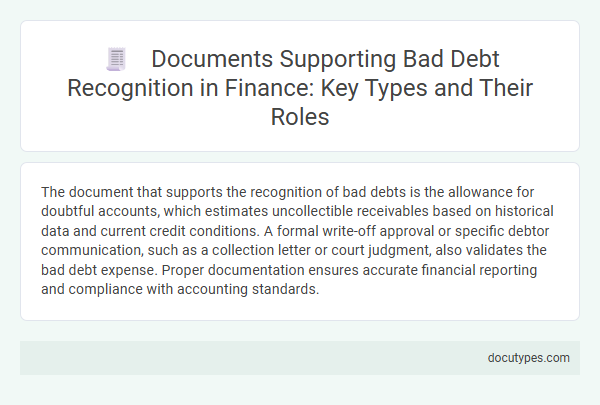The document that supports the recognition of bad debts is the allowance for doubtful accounts, which estimates uncollectible receivables based on historical data and current credit conditions. A formal write-off approval or specific debtor communication, such as a collection letter or court judgment, also validates the bad debt expense. Proper documentation ensures accurate financial reporting and compliance with accounting standards.
Introduction to Bad Debt Recognition in Finance
Recognizing bad debts is a crucial process in financial accounting that ensures accurate reporting of receivables. Understanding which document supports the recognition of bad debts helps maintain the integrity of your financial statements.
- Accounts Receivable Aging Report - This report categorizes outstanding invoices by their due dates, highlighting overdue accounts that may become bad debts.
- Bad Debt Expense Journal Entry - This document records the estimated amount of receivables deemed uncollectible for the accounting period.
- Write-off Authorization Form - This form authorizes the removal of specific uncollectible accounts from the receivables ledger.
Proper documentation supports accurate bad debt recognition, ensuring compliance with accounting standards and financial transparency.
Importance of Supporting Documentation for Bad Debt
Which document supports the recognition of bad debts? Proper supporting documentation is essential to validate the write-off of uncollectible accounts. Documents such as customer correspondence, collection efforts, and aging reports provide critical evidence for bad debt recognition.
Customer Account Statements and Their Role
Customer account statements play a crucial role in supporting the recognition of bad debts for businesses. These documents provide detailed records of outstanding balances, payment history, and unresolved invoices.
- Customer Account Statement - Displays the transaction history between the company and the customer, highlighting overdue payments.
- Invoice Records - Serve as formal requests for payment that, when unpaid, contribute to identifying bad debts.
- Payment History Reports - Track previous payments and missed deadlines to assess the likelihood of debt recovery.
Invoices and Credit Agreements as Evidence
Invoices serve as primary evidence in recognizing bad debts by detailing the amount owed and payment terms. Credit agreements support this recognition by outlining the contractual obligations between parties and conditions for default. You should retain both documents to substantiate bad debt claims accurately in financial records.
Collection Efforts Documentation
Proper documentation is crucial to support the recognition of bad debts in financial records. Collection efforts documentation provides the necessary evidence to justify uncollectible accounts.
- Demand Letters - Written communication to debtors demonstrates your attempts to recover the outstanding amounts.
- Payment History - Records of missed or partial payments highlight the debtor's inability to pay.
- Collection Agency Reports - Documentation from third-party agencies confirms professional collection efforts and outcomes.
Correspondence Records with Debtors
Correspondence records with debtors serve as critical documentation supporting the recognition of bad debts. These records provide evidence of communication attempts, payment discussions, and acknowledgments of debt issues.
Such documents help establish the efforts made to collect outstanding amounts and validate the classification of a debt as uncollectible. Financial auditors rely on this correspondence to justify writing off bad debts in financial statements.
Legal Notices and Court Documents
| Document Type | Description | Role in Bad Debt Recognition | Legal Relevance |
|---|---|---|---|
| Legal Notice | Formal written communication sent to a debtor notifying them of outstanding payments and the intention to take legal action if debts remain unpaid. | Serves as proof of the creditor's effort to collect the debt, supporting the classification of the amount as bad debt after non-response or non-payment. | Establishes the debtor's awareness of the obligation and the creditor's compliance with legal debt collection requirements. |
| Court Judgment | Official decision issued by a court confirming the debt is owed by the debtor and legally enforceable. | Provides legal validation for the debt, often required for definitive recognition and write-off of bad debts in financial records. | Enables the creditor to enforce collection through legal means, strengthening the position for debt recovery or formal write-off. |
| Bankruptcy Notice | Documentation indicating the debtor has declared bankruptcy or insolvency. | Supports recognition of bad debts where recovery is unlikely due to debtor's legal insolvency. | Triggers legal provisions preventing further collection efforts and authorizes accounting recognition of debt loss. |
| Demand Letter | Written demand requesting payment of overdue debt before court proceedings initiate. | Demonstrates creditor's attempt to collect debt and informs accounting of potential bad debt status. | Acts as a prerequisite notice in many jurisdictions before filing lawsuits or credit write-offs. |
Internal Approval and Write-Off Authorization Forms
Internal approval and write-off authorization forms are essential documents supporting the recognition of bad debts within a finance department. These forms provide formal evidence that a debt has been evaluated and deemed uncollectible by authorized personnel.
The internal approval form ensures that bad debts undergo proper review and compliance with company policies before recognition. Write-off authorization forms serve as official records, documenting the approval to remove the debt from accounts receivable. Together, these documents establish accountability and support accurate financial reporting.
External Auditor and Accountant Reports
External auditor reports provide critical validation for the recognition of bad debts by thoroughly examining the accuracy of financial statements and confirming adherence to accounting standards. Accountant reports support this process by detailing the methodologies used to identify and estimate uncollectible accounts, ensuring transparency and compliance. Together, these documents offer a comprehensive basis for recognizing bad debts in financial records, enhancing credibility for stakeholders.
Which Document Supports the Recognition of Bad Debts? Infographic

